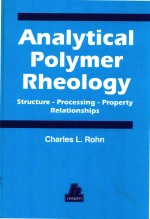

Analytical polymer rheology structure-processing-property relationshipsPDF电子书下载
- 电子书积分:12 积分如何计算积分?
- 作 者:Charles L. Rohn
- 出 版 社:Hanser Publishers
- 出版年份:1995
- ISBN:156990149X
- 页数:314 页
Chapter 1 History of Rheology and Macromolecular Science 1
Chapter 2 Principles of Mechanics 12
2.1 Introduction 12
2.2 Classical Mechanics 12
2.2.1 Newton’s First Law of Motion 13
2.2.2 Newton’s Second Law of Motion 16
2.2.3 Newton’s Third Law of Motion 19
2.3 Rotational Motion 20
2.4 Angular Momentum 22
2.5 Oscillatory Motion 24
2.6 Natural Frequencies and Resonance 26
Chapter 3 Stress and Strain 30
3.1 Introduction 30
3.2 Strain Tensor 30
3.3 Continuum Concept 33
3.4 Engineering Elasticity 37
3.5 Viscosity 41
3.6 Constitutive Equations 43
Chapter 4 Gases 47
4.1 Introduction 47
4.2 Kinetic Theory 47
4.3 Distribution of Molecular Velocities 51
4.4 Molecular Effusion 53
4.5 Transport Processes 55
4.6 Molecular Diffusion 58
4.7 Heat Transfer 60
4.8 Principle of Equipartition of Energy 61
4.9 Nonideal Gases 63
4.10 Law of Corresponding States 64
4.11 Intermolecular Interactions 65
4.12 Relaxation Times 69
4.13 Appendix 70
4.13.1 Thermodynamics 70
Chapter 5 Rubber 76
5.1 Introduction 76
5.2 Thermodynamics 76
5.3 Tensile/Compression Stress-Strain Properties 80
5.4 Distribution of Rubbery Chain Conformations Due to an External Stress 82
5.5 Tensile Strength 84
5.6 Rubber Products 85
5.6.1 Tank Tread Problem 89
5.6.2 Rack-and-Pinion Seal 90
Chapter 6 Solids 92
6.1 Perfect Crystals 92
6.2 Imperfect Crystals 104
6.3 Polymeric Crystals 107
6.4 Semicrystalline Polymers 109
6.5 Amorphous Solids 111
6.6 Oriented Polymers 111
Chapter 7 Fluids and Polymer Solutions 117
7.1 Introduction 117
7.2 Free-Volume (Hole) Theory 118
7.3 Polymer Solutions 121
7.4 Gel Permeation Chromatography 123
7.5 Rouse Model 125
Chapter 8 Polymer Melts 130
8.1 Introduction 130
8.2 Shear Rate and Frequency Dependence of Viscosity 130
8.3 Shear Rate and Frequency Dependence of Elasticity 135
8.4 Temperature Dependence of Viscosity 141
8.5 Extensional Viscosity: Melt Tension and Draw Down 143
8.6 Reptation Theory (Tube Model) 148
Chapter 9 Phase Changes and Transitions 152
9.1 Introduction 152
9.2 First Order Transitions 152
9.3 Crystallization and Melting 154
9.4 Homopolymers 156
9.5 Copolymers 160
9.6 Glass Transition 171
9.7 Transition Region 174
9.8 Secondary Transitions 180
9.9 Modulus-Temperature Curves 183
Chapter 10 Suspensions 189
10.1 Introduction 189
10.2 Viscoelasticity of Suspensions 189
10.3 Electrostatic Interactions 193
10.4 Steric Interactions 195
10.5 Polymer Blends 196
10.6 Compatible Blends 197
10.7 Incompatible Blends 197
10.8 Block Copolymers 199
10.9 Interpenetrating Polymer Networks 199
10.10 Filled Plastics 201
10.11 Phase Separation and Storage Stability 202
10.12 Flow and Leveling 204
10.13 Flow and Sagging 205
Chapter 11 Linear Viscoelasticity 209
11.1 Introduction 209
11.2 Maxwell Model 209
11.3 Boltzmann Superposition Principle 210
11.4 Creep Properties 212
11.5 Stress Relaxation Properties 217
11.6 Dynamic Mechanical Properties 218
Chapter 12 Rheological Testing 222
12.1 Introduction 222
12.2 Principles of Rheological Measurements 223
12.2.1 Strain Dependence 224
12.2.2 Frequency (Rate) Dependence 224
12.2.3 Temperature Dependence 225
12.2.4 Temperature-Frequency Dependence 227
12.3 Fluids Testing 227
12.3.1 Effusion of Gases Experiment 227
12.3.2 Capillary Viscometer 228
12.4 Experimental Measurements of Fluids 234
12.5 Rotational Viscometers 236
12.6 Solids Testing 239
12.6.1 Statics 239
12.6.2 Tensile Testing 240
12.6.3 Compressive Testings 241
12.6.4 Flexural Testing 243
12.6.5 Torsional Testing 247
12.6.6 Impact Testing 249
12.6.7 Tear Testing 251
12.7 Oscillatory Testing 251
Chapter 13 Polymer Fabrication and Properties 256
13.1 Introduction 256
13.2 Extrusion 258
13.2.1 Extrusion Quality 261
13.2.2 Extruder Dies 264
13.3 Output Rates 264
13.3.1 Die Swell 265
13.3.2 Haze and Gloss of Films 272
13.3.3 Toughness of Blown Films 274
13.4 Injection Molding 278
13.5 Using Rheology to Predict Long-Time Durability of Plastic Products 278
13.6 Physical Aging 279
13.7 Using Rheology to Predict Toughness of Plastic Products 280
13.8 Impact Strength 281
13.9 Summary 283
Chapter 14 Yielding and Fracture 286
14.1 Introduction 286
14.2 Theoretical Strength 286
14.3 Yielding Behavior 288
14.3.1 Amorphous Polymers 288
14.3.2 Semicrystalline Polymers 290
14.4 Fundamentals of Fracture Mechanics 293
14.4.1 Hooke’s Law-Lattice Energy Theory 298
14.4.2 Free Volume Theory 299
14.4.3 Proof of Theory 300
Index 307
- 《运筹学 原书第2版》(美)罗纳德 L.拉丁 2018
- 《教自闭症孩子主动发起和自我管理 应用关键反应训练提高社交技能》(美)Lynn Kern Koegel,(美)Robert L. Koegel著 2019
- 《微观经济学》(美)罗伯特·S. 平狄克,(美)丹尼尔·L.鲁宾费尔德著 2019
- 《哈里森内科学 第19版 双语版 上》(美)丹尼斯·L.卡斯帕(Dennis L. Kasper),(美)安东尼·S.福奇由(Anthony S.Fauci),(美)斯蒂芬·L.豪泽(Stephen L.Hauser)著;王海译 2019
- 《国际经典影像诊断学丛书 头颈部影像诊断学》王振常,鲜军舫,燕飞,赵鹏飞译;(美)贝尔纳黛特·L.科 2019
- 《你也可以创造生命的奇迹 来自全球的自我疗愈实证与方法 miraculous moments and extraordinary stories from people all over the w》露易丝·贺(Louise L. Hay)著 2012
- 《新生代消费者要什么》(美)格雷格·L.威特,(美)德里克·E.贝尔德著 2019
- 《云计算解决方案架构设计》(美)凯文·L.杰克逊(Kevin L. Jackson) 2020
- 《心狱 社会小说 第3版》(俄)L.托尔斯泰著
- 《美国法律文献检索 第12版》(美)莫里斯·L.柯恩 2020
- 《芝加哥手册 第16版》吴波著,THE UNIVERSITY OF CHICAGO PRESS译 2014
- 《认同的力量》曼纽尔·卡斯特(Manuel Castells)著;夏铸九,黄丽玲等译 2003
- 《ASPEN PUBLISHERS PRETRIAL ADVOCACY PLANNING》ANALYSIS 2010
- 《ASPEN PUBLISHERS ESL HANDBOOK SOURCES》TECHNOLOGY AND PROCESS 2011 EDITION 2011
- 《ASPEN PUBLISHERS INTERNATIONAL BUSINESS TRANSACTIONS PROBLEMS》CASES 2010
- 《ASPEN PUBLISHERS LEGAL WRITING AND OTHER LAWYERING SKILLS FIFTH EDITION》NANCY L.SCHULTZ LOUIS J.SIRICO 2010
- 《ASPEN PUBLISHERS DRUNK DRIVING DEFENSE SEVENTH EDITION》LAWRENCE TAYLOR 2010
- 《Books in print 1987-88; volume 7: publishers》 1987
- 《ASPEN PUBLISHERS LAW FOR SOCIETY NATURE》FUNCTIONS 2010
- 《ASPEN PUBLISHERS INTERVIEWING AND INVESTIGATING ESSENTIAL SKILLS FOR THE LEGAL PROFESSIONAL FOURT》STEPHEN P.PARSONS 2010
